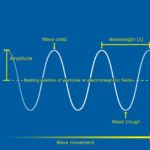Energy can move through substances in the form of waves. Waves are a type of energy that travels through a substance by vibrating the particles of that substance. The energy of the wave travels through the substance, but the particles of the substance do not move forward. Instead, they vibrate back and forth around their original position.
Waves are typically circular and move outward from a central location. This is called a circular wave. When a stone is thrown into a pond, it creates circular waves that move outward from the point where the stone hit the water.
Waves are measured using two important properties: wavelength and amplitude. Wavelength is the distance between the peaks of two consecutive waves. Amplitude is the height of a wave from the center to its peak.
There are different types of waves, including mechanical waves and electromagnetic waves. Mechanical waves are waves that need a substance to travel through, like sound waves in air or water waves in the ocean. Electromagnetic waves do not need a substance to travel through and can travel through empty space, like light waves and radio waves.
Understanding how waves move through substances can help us learn more about the world around us and how we can use them to our benefit. For example, we can use waves to communicate with each other using radio and television, and we can use waves to generate electricity using solar panels.






